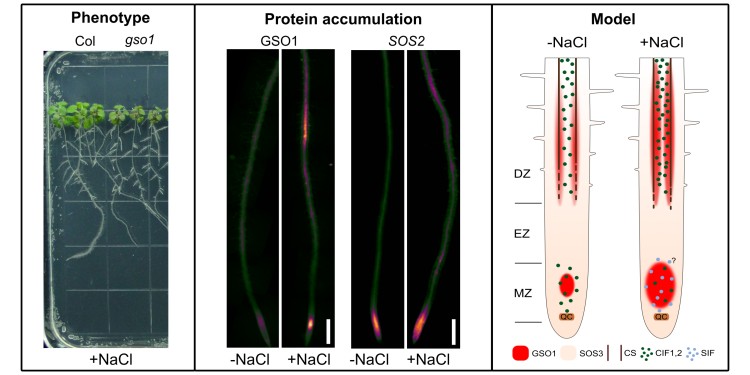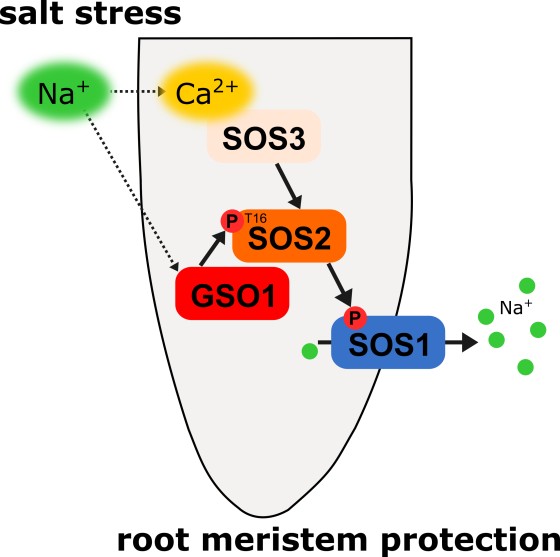
Researchers find new mechanism for sodium salt detoxification in plants
A high content of sodium-containing salts in the soil is a problem for many plants: as a result, they grow less well, or not at all. Soil salinisation is seen as one of the greatest threats to being able to feed the world’s population because it makes soils increasingly infertile, especially in dry regions. A team of Chinese, German and Spanish researchers, including Prof Jörg Kudla and his team from the University of Münster, has now found a mechanism in thale cress (Arabidopsis thaliana) which enables plants to provide protection against salt stress for their sensitive stem cells in the meristem at the root tip. The meristem, which ensures that the root constantly forms new cells and can thus grow, is particularly sensitive: in contrast to fully formed plant cells, its cells have no vacuole inside where harmful substances can be disposed of.
The discovery that plants can provide protection against toxic salt stress specifically for individual groups of cells came as something of a surprise to the researchers. Although it was already known that there are various mechanisms in plants enabling them to cope with high salt contents in soil water – one is an active transportation of salt out of the cells, another is the mechanical impregnation of a specific cell layer in the root – what was not known was that plants also specifically protect the stem cells in their roots. “The signalling pathway we have discovered – which combines components of known salt-stress signalling pathways with signalling proteins for the purpose of controlling root development – serves the additional purpose of specifically detoxifying the plant,” says Jörg Kudla.

In addition, the team demonstrated that GSO1 also helps to prevent too much salt from penetrating into the vascular tissue of the root. This vascular tissue is located in the interior of the plant and transports water and minerals from the roots into the leaves. By a mechanical barrier, the Casparian strip, it is protected from minerals dissolved in the soil water penetrating into it in an uncontrolled fashion. The researchers also demonstrated a higher GSO1 content in the cells forming the Casparian strip increases due to salt stress.
“GSO1 is a receptor kinase well known in plant developmental biology,” says Jörg Kudla. “It plays an important role in various stages in a plant’s development. Now, for the first time, we were able to demonstrate that it also plays a role in salt tolerance and activates the ‘sodium-out pump’ via an alternative signalling pathway which is presumably not dependent on calcium.” Calcium signals in the cells play a key role in other known adaptive responses of plants to salt stress.
About the methods: The team discovered the significance of GSO1 by comparing numerous mutants of various receptor-like kinases in the thale cress. By studying protein interactions, they identified the reaction partners of the enzyme within the signalling pathways for protecting the meristem and forming the Casparian strip. Methods used in further investigations included mass spectrometry and high-resolution microscopy.
The work received financial support from the National Natural Science Foundation of China and from the German Research Foundation (DFG) for a joint project undertaken by teams from Münster and Beijing, as well as from the National Basic Research Program of China, Spain’s Agencia Estatal de Investigación, the European Regional Development Fund and the Chinese Scholarship Council.
Original publication
Changxi Chen, Gefeng He, Jianfang Li, Javier Perez-Hormaeche, Tobias Becker, Manqing Luo, Lukas Wallrad, Jia Li, José M. Pardo, Jörg Kudla, Yan Guo (2023): A salt stress-activated GSO1-SOS2-SOS1 module confers Na+ extrusion for root meristem protection. The EMBO Journal (2023) e113004; DOI: 10.15252/embj.2022113004
